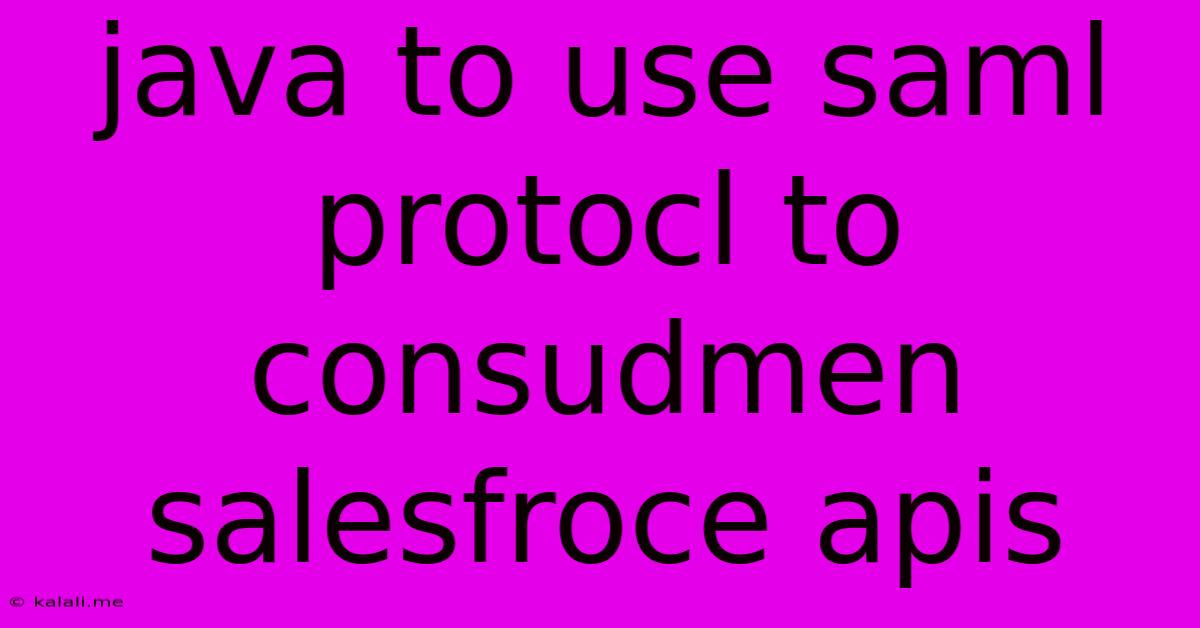Java To Use Saml Protocl To Consudmen Salesfroce Apis
Kalali
May 24, 2025 · 3 min read

Table of Contents
Leveraging SAML 2.0 for Secure Java-based Salesforce API Consumption
This article explores how Java applications can securely consume Salesforce APIs using the Security Assertion Markup Language (SAML) 2.0 protocol. SAML 2.0 provides a robust and widely adopted standard for federated identity management, enabling secure access to resources without exchanging passwords directly. This is particularly beneficial when interacting with sensitive Salesforce data.
Understanding the Need for Secure Salesforce API Access
Salesforce APIs provide powerful functionalities for extending and integrating with the Salesforce platform. However, securing access to these APIs is paramount to protect sensitive business data. Using plain usernames and passwords is highly insecure and vulnerable to various attacks. SAML 2.0 offers a more secure alternative, allowing authentication through an established identity provider (IdP) and eliminating the need to directly handle Salesforce credentials within your Java application.
Key Components in the SAML-based Salesforce Integration
Implementing SAML 2.0 for Salesforce API access involves several key components:
- Identity Provider (IdP): This is a trusted entity, often your organization's internal system or a third-party provider, that verifies the user's identity. Salesforce can act as an IdP as well, depending on your setup.
- Service Provider (SP): This is your Java application that needs to access Salesforce APIs.
- SAML Assertion: This XML document contains the user's authentication information, including attributes and claims, and is exchanged between the IdP and SP.
- SAML Libraries: Java libraries are essential for handling SAML message processing, signature verification, and other related tasks. Popular choices include OpenSAML and XMLSec.
Implementing SAML 2.0 with Java: A Step-by-Step Guide
While a complete code example would be extensive, let's outline the key steps involved in integrating SAML 2.0 with your Java application for secure Salesforce API access:
-
Setting up Salesforce: Configure Salesforce to accept SAML-based authentication. This typically involves creating a connected app and specifying the IdP metadata URL. This process will provide you with a crucial metadata XML file containing information needed to communicate with Salesforce's SAML endpoint.
-
Choosing a SAML Library: Select a suitable Java SAML library (e.g., OpenSAML). This library will handle the complexities of generating, validating, and exchanging SAML messages.
-
Building the SAML Request: Your Java application will initiate the SAML authentication process by building an authentication request and sending it to the IdP (or Salesforce acting as IdP).
-
IdP Authentication and Assertion Generation: The IdP verifies the user's identity, and upon successful authentication, generates a SAML assertion containing user attributes and claims.
-
SAML Response Processing: Your Java application receives the SAML response containing the assertion. The SAML library will help validate the signature, ensuring the assertion's integrity. This step involves verifying the signature, checking the assertion's validity, and extracting relevant user attributes.
-
Access Salesforce APIs with the Security Token: Once the assertion is validated, extract the necessary security token (often a session ID) and use it to authenticate your subsequent calls to Salesforce APIs. Use this token within your API calls to authorize requests.
-
Handling SAML Errors: Implement appropriate error handling to manage situations like authentication failures, invalid assertions, and other potential problems.
Advanced Considerations:
- Single Logout (SLO): Implement SLO to securely terminate user sessions across both the IdP and SP.
- Attribute Mapping: Carefully configure the attribute mapping between your IdP and Salesforce to ensure seamless user information exchange.
- Security Best Practices: Follow industry best practices for secure coding, input validation, and protecting sensitive information like security tokens.
Conclusion:
Using SAML 2.0 for secure access to Salesforce APIs is a best practice for any Java application that interacts with sensitive Salesforce data. While implementing SAML might seem complex, using appropriate Java libraries simplifies the process significantly, providing a robust and secure method for integrating with the Salesforce platform. Remember to thoroughly test your implementation and follow security best practices throughout the development lifecycle. This approach significantly enhances security and reduces the risk associated with exposing sensitive Salesforce credentials directly in your application code.
Latest Posts
Latest Posts
-
How Many Grams Is Half An Oz
Jul 06, 2025
-
How Much Is 10 Quarters In Dollars
Jul 06, 2025
-
How Do You Beat Stage 9 On Bloxorz
Jul 06, 2025
-
What Is 1 2 Equivalent To In Fractions
Jul 06, 2025
-
How Do You Say Pork In Spanish
Jul 06, 2025
Related Post
Thank you for visiting our website which covers about Java To Use Saml Protocl To Consudmen Salesfroce Apis . We hope the information provided has been useful to you. Feel free to contact us if you have any questions or need further assistance. See you next time and don't miss to bookmark.